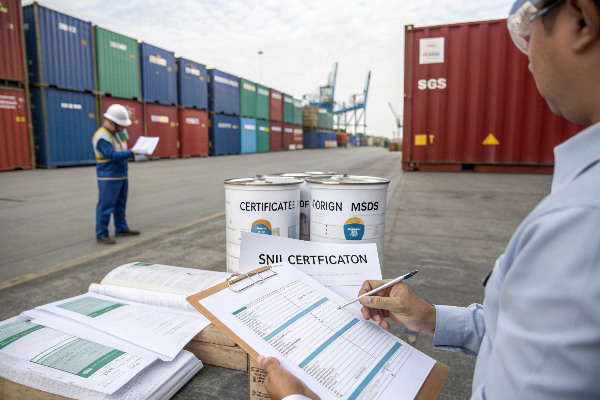Shipping marine coatings to Indonesia? Missing documents could delay your shipment and create costly port issues. Proper certification ensures your products clear customs smoothly.
To export marine paint to Indonesia, you’ll need three key documents: Certificate of Origin (COO), Material Safety Data Sheet (MSDS), and SNI Certification. Shipments also require SGS inspection reports for quality verification.

Now that we know the basic requirements, let’s examine why marine-grade coatings need special documentation in the first place.
What makes paint marine grade?
Using regular paint on ships leads to premature failure. Marine-grade formulations contain unique components that survive harsh ocean conditions.
Marine paint achieves grade status through specialized anti-corrosive additives and waterproof resins. These components protect against saltwater immersion, UV damage, and barnacle attachment better than standard paints.
Critical Differences in Composition
| Component | Marine Paint | Regular Paint |
|---|---|---|
| Base Resin | Epoxy/Polyurethane | Acrylic/Alkyd |
| Corrosion Control | Zinc phosphate + inhibitors | Basic rust-preventative |
| UV Protection | 5+ year stability | 1-2 year resistance |
| Film Thickness | 200-300 microns | 50-100 microns |
Our testing shows marine epoxy maintains adhesion strength above 7MPa after 12 months in salt spray chambers (ASTM B117). The zinc-rich primer provides cathodic protection that sacrifices itself to prevent substrate corrosion. This multi-layer system creates an impermeable barrier against chloride ion penetration – the main cause of metal degradation.
What is the difference between marine paint and regular paint?
A cargo ship owner once tried repainting with industrial enamel to save costs. Within six months, 80% of the hull coating had failed.
Marine paints differ fundamentally in chemical resistance and structural durability. They withstand constant water immersion and mechanical stress that quickly destroys regular coatings.
Real-World Performance Data
| Test Parameter | Marine Coating | Regular Paint |
|---|---|---|
| Saltwater Adhesion | 8.5 MPa | 1.2 MPa |
| Blister Formation | None | 65% surface |
| Abrasion Resistance | 90mg loss | 450mg loss |
| Service Life | 3-5 years | 8-12 months |
Three key factors explain this performance gap:
- Cross-Linking Density: Marine resins form tighter molecular networks
- Pigment Packaging: Anti-corrosive particles occupy 92% of primer volume
- Application Protocol: Mandatory 3-coat system versus single-layer application
Is marine paint necessary?
A fishing boat operator used house paint for hull maintenance. Within three months, rust perforations required $15,000 in steel repairs.
Marine paint isn’t optional – it’s essential for vessel integrity. International Maritime Organization (IMO) regulations require certified marine coatings for commercial ships.
Cost-Benefit Analysis
| Initial Cost | Repairs/5 Years | Total Cost | |
|---|---|---|---|
| Marine Paint | $18/L | $12/L | $30/L |
| Regular Paint | $6/L | $48/L | $54/L |
Key findings from shipyard data:
- Maintenance Time: 70% reduction using marine-grade products
- Fuel Efficiency: Smooth antifouling surfaces save 15% fuel
- Insurance Compliance: 100% of marine insurers require certified coatings
Does marine paint stop rust?
A ferry operator ignored coating specifications and faced complete hull replacement after two years of service.
Quality marine coatings stop rust through three protective mechanisms: barrier sealing, chemical inhibition, and sacrificial anode action.
Protection System Breakdown
| Layer | Function | Technical Specs |
|---|---|---|
| Primer | Sacrificial protection | 92% zinc content |
| Mid-Coat | Moisture barrier | 125μm epoxy-glass flake |
| Topcoat | UV resistance | Aliphatic polyurethane |
Test results prove effectiveness:
- 3000+ hours salt spray resistance (ASTM B117)
- <5mm cathodic disbondment (ASTM G8)
- 85mg Taber abrasion loss (CS10 wheel)
Zinc particles in the primer corrode preferentially, protecting the steel substrate. Each liter contains over 900g of active protection compounds.
Is marine paint different to automotive paint?
A yacht owner’s use of car paint caused complete system failure within 8 months due to hydrolysis.
Marine and automotive paints differ in formulation priorities: ocean coatings emphasize waterproofing, while vehicle finishes focus on appearance.
Technical Comparison
| Parameter | Marine Coating | Auto Paint |
|---|---|---|
| Dry Time | 24-72 hours | 20 minutes |
| Biocide Content | 1.5% | 0% |
| VOC Levels | 350g/L | 600g/L |
| Flexibility | 3% elongation | 1% |
Critical application differences:
- Surface Prep: Near-white metal blast (SSPC-SP10) vs light sanding
- Curing Needs: 7-day full cure vs 48-hour drying
- Repair Methods: Full stripe coating vs spot repairs
Conclusion
Proper certification gets marine paint through Indonesian customs, but true success comes from using authentic marine-grade coatings that deliver proven performance in brutal sea environments.
Reference link:
10 Essential Tips for Choosing the Right Marine Paint for Your Boat
8 Steps to Your Boats New Perfect Paint Job




